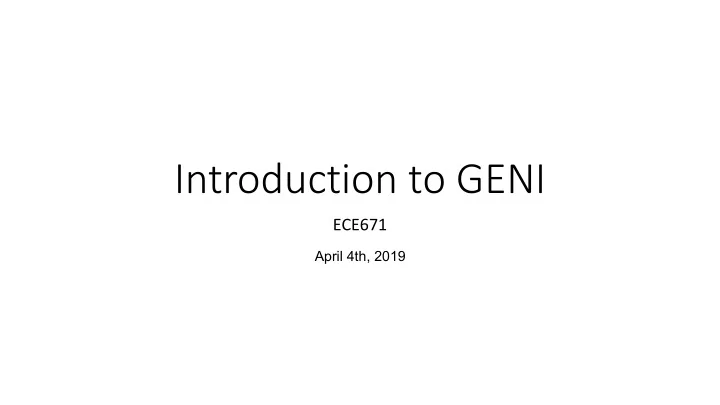

Introduction to GENI ECE671 March 22 nd , 2018 April 4th, 2019
Outline • Testbeds – What are they? • GENI Testbed • What resources do I select? • How can I reserve resources? • The learning switch – hands-on tutorial • Systematic Experiment Design • Automate Orchestration • OVS Commands – Setup bridge and Debug commands • Useful links – OpenFlow and GENI
Testbeds – What are they? Commercial • Resources for developing and prototyping systems Research • E.g. Two laptops connected by a switch http://en0.ch/2014/07/routers-vs-switches-whats-the-difference/ • Network testbeds • Frµit - 10,000 Raspberry Pis! • GENI - Global Environment for Network Innovations • Geographically distributed compute and storage connected by Gigabit fiber • Largest OpenFlow enabled testbed https://www.zdnet.com/pictures
Layer-2 network prototyping is possible! http://www.geni.net/
What resources do I select? • Type of resources • Type of Aggregate Managers • Raw PC • InstaGENI • Virtual Machine • Smaller resources (compute and storage), many in number • Containers • Xen virtualization • Xen and KVM • Limited public IPs • Link Type • ExoGENI • Local • Larger resources (compute and storage), fewer in • Stitched number • KVM Virtualization • Default Public IPs
Hands-On tutorial • Learning Localhost Switch – E.g. InstaGENI http://groups.geni.net/geni/wiki/GENIExperimenter/Tutorials/OpenFlowRyu/DesignSetup
Systematic Experimentation client router router Add other nodes - Test application router router router router router - Automate router server router Start small Add similar nodes - Create Image and local links client Create a stitched router - Test connectivity topology and bandwidth - Test connectivity - Test image router router and bandwidth - Automate - Test application - Automate server router Adapted from Slides by Xuan Liu: https://groups.geni.net/geni/wiki/GENIExperimenter/Tutorials/ SystematicExprCaseStudy#ATutorialonSystematicExperimentalDesign
Automate Orchestration • Login to resources • SSH key pair - Public-private key authentication • Private key stored in secure location on your system (e.g. ~/.ssh) • Public key uploaded on resource • System can be sure you are the one logging in since you need to use your private key • Images and PostBoot Scripts • Custom Images • Install and execute • Ansible • YAML-like syntax • Remotely run commands on machine (ping, iperf etc.) • Paramiko • Python library – login and remotely run commands on machine • Jupyter • Web-based interface – login and run commands, plot results using matplotlib
OVS – Bridge setup and debug commands • Name of bridge can be anything but name of the port should be the same as what you see when you run “ifconfig” for the interfaces that you wish to add to the bridge • sudo ovs-vsctl add-br <name_of_bridge> • sudo ovs-vsctl add-port <name_of_bridge> <name_of_port> • Set controller for bridge – In this example, IP=127.0.0.1 • sudo ovs-vsctl set-controller <name_of_bridge> tcp:<ip_of_controller>:6653 • Set secure mode – This is used so that traffic is NOT routed by the OVS until the rule is explicitly specified by the controller • sudo ovs-vsctl set-fail-mode <name_of_bridge> secure • Check flow table to see what flow rules have been installed • sudo ovs-ofctl dump-flows <name_of_bridge>
Useful Links – OpenFlow and GENI • http://docs.openvswitch.org/en/latest/ • https://openflow.stanford.edu/display/ONL/POX+Wiki • http://groups.geni.net/geni/wiki/GENIExperimenter/Tutorials • Not all of these are being actively maintained but it should give an idea of what you can do with GENI • https://www.youtube.com/watch?v=s-2mWDJLiRo – Lab Zero (A simple experiment using GENI) - Jupyter Tutorial: https://docs.google.com/document/d/ 1ThSGBSFCgSSptoGzkyml8tzLltb1MxHYsMvEQYSbxEs For specific questions e-mail me at divyashri.bhat@gmail.com with the subject line: ECE671-2019-GENI
Recommend
More recommend